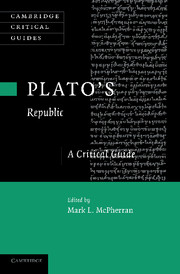Book contents
- Frontmatter
- Contents
- Acknowledgments
- List of contributors
- List of abbreviations
- Introduction
- 1 Socrates in the Republic
- 2 Platonic ring-composition and Republic 10
- 3 The Atlantis story: the Republic and the Timaeus
- 4 Ethics and politics in Socrates' defense of justice
- 5 Return to the cave
- 6 Degenerate regimes in Plato's Republic
- 7 Virtue, luck, and choice at the end of the Republic
- 8 Plato's divided soul
- 9 The meaning of “saphēneia” in Plato's Divided Line
- 10 Plato's philosophical method in the Republic: the Divided Line (510b–511d)
- 11 Blindness and reorientation: education and the acquisition of knowledge in the Republic
- 12 Music all pow'rful
- Bibliography
- Index of passages
- Index of names and subjects
Introduction
Published online by Cambridge University Press: 04 February 2011
- Frontmatter
- Contents
- Acknowledgments
- List of contributors
- List of abbreviations
- Introduction
- 1 Socrates in the Republic
- 2 Platonic ring-composition and Republic 10
- 3 The Atlantis story: the Republic and the Timaeus
- 4 Ethics and politics in Socrates' defense of justice
- 5 Return to the cave
- 6 Degenerate regimes in Plato's Republic
- 7 Virtue, luck, and choice at the end of the Republic
- 8 Plato's divided soul
- 9 The meaning of “saphēneia” in Plato's Divided Line
- 10 Plato's philosophical method in the Republic: the Divided Line (510b–511d)
- 11 Blindness and reorientation: education and the acquisition of knowledge in the Republic
- 12 Music all pow'rful
- Bibliography
- Index of passages
- Index of names and subjects
Summary
The first sentence of Plato's Republic recounts how Socrates went on a journey of descent – a katabasis – leaving the secure walls of Athens in order to celebrate the introduction of a new worship:
I went down yesterday to the Piraeus with Glaucon, the son of Ariston, to say a prayer to the goddess [Bendis], and because I was also curious to see how they would conduct the festival, since this was its inauguration.
(Rep. 327a1–3)With this opening metaphor of descent – and continuing on through its central books of ascent to the final mythical katabasis and revelatory reascent (anabasis) of the Myth of Er (614b–621d) – Plato's Republic announces itself to be an original and revolutionary journey toward the truth, passing through extraordinarily mysterious terrain. This opening also suggests what the text goes on to confirm, namely, that the purpose of the Republic is to introduce a new cult outside the walls of the traditional dispensation. The divinity of this sect proves not to be a Thracian night-goddess, however, but the Reality of the Form-world, and its new worship involves not nocturnal horse races (328a), but the intellectual activity of philosophizing whose sacrificial rewards are threefold: wisdom, happiness, and the assurance of immortality.
- Type
- Chapter
- Information
- Plato's 'Republic'A Critical Guide, pp. 1 - 10Publisher: Cambridge University PressPrint publication year: 2010

